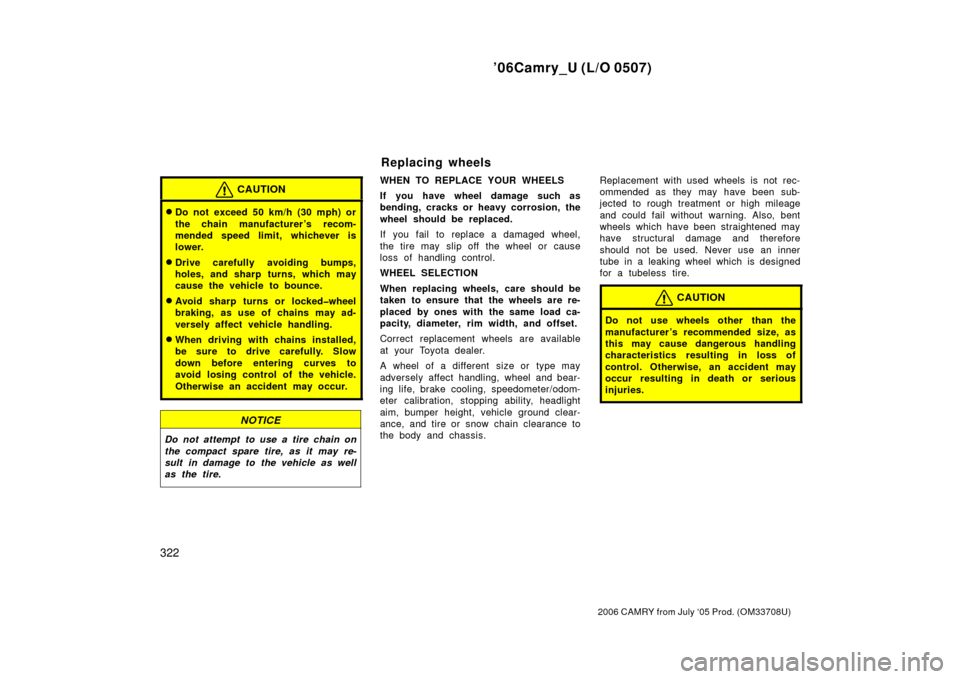Page 291 of 357
’06Camry_U (L/O 0507)
283
2006 CAMRY from July ‘05 Prod. (OM33708U)
1. Remove and turn over the spare tirecover. Remove the front towing eyelet
by turning it as shown in the illustra-
tions.
2. Remove the front towing eyelet coveron the front bumper, using a flat −
bladed screwdriver which is wrapped
with a cloth.3. Secure the front towing eyelet to the hole on the bumper by turning clock-
wise.
Page 323 of 357

’06Camry_U (L/O 0507)
315
2006 CAMRY from July ‘05 Prod. (OM33708U)
Keep your tire inflation pressures
at the proper level.
The recommended cold tire inflation
pressures, tire sizes and the com-
bined weight of occupants and cargo
(vehicle capacity weight) are de-
scribed on page 336 and 340. They
are also on the tire and loading infor-
mation label.
You should check the tire inflation
pressure every two weeks, or at least
once a month. And do not forget the
spare! The following instructions for
checking tire inflation pressure
should be observed:
� The pressure s hould be
checked only when the tires are
cold. If your vehicle has been
parked for at least 3 hours and has
not been driven for more than 1.5
km or 1 mile since, you will get
an accurate cold tire inflation pres-
sure reading.
� Always use a tire pressure
gauge. The appearance of a tire
can be misleading. Besides, tire
inflation pressures that are even
just a few pounds off can degrade
ride and handling.
� Take special care when adding
air to the compact spare tire.
The smaller tire size can gain
pressure very qu ickly. Add com-
pressed air in small quantities and
check the pressure often until it
reaches the specified pressure. �
Do not bleed or reduce tire
inflation pressure after driving.
It is normal for the tire inflation
pressure to be higher after driving.
� Never exceed the vehicle capac-
ity weight. Passenger and lug-
gage weight should be located so
that the vehicle is balanced.
Page 326 of 357

’06Camry_U (L/O 0507)
318
2006 CAMRY from July ‘05 Prod. (OM33708U)
If air loss occurs while driving, do not
continue driving. Driving even a short
distance can damage a tire beyond
repair.
An y ti res wh i ch are over 6 years
old must be checked by a qualified
technician even if damage is not
obvious.
Tires deteriorate with age even if they
have never or seldom been used.
This applies also to the spare tire and
tires stored for future use.REPLACING YOUR TIRES
When replacing a tire, use a tire of
the same size and construction,
and the same or greater maximum
load as the originally installed
tires.
Using any other size or type of tire
may seriously affect handling, ride,
speedometer/odometer calibration,
ground clearance, and clearance be-
tween the body and tires or snow
chains.
Check that the maximum load of the
replaced tire is greater than 1/2 of the
Gross Axle Weight Ratings (GAWR)
of either the front axle or the rear
axle, whichever is greater. As for the
maximum load of the tire, see the load
limit at maximum cold tire inflation
pressure mentioned on the sidewall
of the tire, and as for the Gross Axle
Weight Ratings (GAWR), see the Cer-
tification Label.
For details about the side wall of the
tire and the Certification Label, see
pages 233 and 230.CAUTION
Observe the following instruc-
tions. Otherwise, an accident
may occur resulting in death or
serious injuries.
�
Do not mix radial, bias belted,
or bias�ply tires on your ve-
hicle, as this may cause dan-
gerous handling characteris-
tics resulting in loss of control.
� Do not use tires other than the
manufacturer’s recommended
size, as this may cause danger-
ous handling characteristics
resulting in loss of control.
Page 327 of 357
’06Camry_U (L/O 0507)
319
2006 CAMRY from July ‘05 Prod. (OM33708U)
Toyota recommends all four tires,
or at least both of the front or rear
tires be replaced at a time as a set.
See “If you have a flat tire” on page
268 in Section 4 for tire change proce-
dure.
When a tire is replaced, the wheel
should always be balanced.
An unbalanced wheel may affect ve-
hicle handling and tire life. Wheels
can get out of balance with regular
use and should therefore be balanced
occasionally.
When replacing a tubeless tire, the
air valve should also be replaced
w i t h a new on e.
With a spare tire of the same
wheel type as the installed tiresWith a spare tire of different
wheel type from the installed
tires
Rotating tires
Page 328 of 357

’06Camry_U (L/O 0507)
320
2006 CAMRY from July ‘05 Prod. (OM33708U)
To equalize the wear and help ex-
tend tire life, Toyota recommends
that you rotate your tires accord-
ing to the maintenance schedule.
(For scheduled maintenance infor-
mation, please refer to the “Sched-
uled Maintenance Guide” or “Own-
er’s Manual Supplement”.)
However, the most appropriate tim-
ing for tire rotation may vary ac-
cording to your driving habits and
road surface conditions.
See “If you have a flat tire” on page
268 in Section 4 for tire change proce-
dure.
When rotating tires, check for uneven
wear and damage. Abnormal wear is
usually caused by incorrect tire pres-
sure, improper wheel alignment, out−
of −balance wheels, or severe braking.CAUTION
Do not include a compact spare
tire when rotating the tires. It is
designed for temporary use only.
WHEN TO USE SNOW TIRES OR
CHAINS
Snow tires or chains are recommended
when driving on snow or ice.
On wet or dry roads, conventional tires
provide better traction than snow tires.
SNOW TIRE SELECTION
If you need snow tires, select tires of
the same size, construction and load
capacity as the originally installed tires.
Do not use tires other than those men-
tioned above. Do not install studded tires
without first checking local regulations for
possible restrictions.
CAUTION
Do not use snow tires other than the
manufacturer ’s recommended size, as
this may cause dangerous handling
characteristics resulting in loss of
control. Otherwise, an accident may
occur resulting in death or serious
injuries.
Installing snow tires and
chains
Page 330 of 357

’06Camry_U (L/O 0507)
322
2006 CAMRY from July ‘05 Prod. (OM33708U)
CAUTION
�Do not exceed 50 km/h (30 mph) or
the chain manufacturer ’s recom-
mended speed limit, whichever is
lower.
�Drive carefully avoiding bumps,
holes, and sharp turns, which may
cause the vehicle to bounce.
�Avoid sharp turns or locked�wheel
braking, as use of chains may ad-
versely affect vehicle handling.
�When driving with chains installed,
be sure to drive carefully. Slow
down before entering curves to
avoid losing control of the vehicle.
Otherwise an accident may occur.
NOTICE
Do not attempt to use a tire chain on
the compact spare tire, as it may re-
sult in damage to the vehicle as well
as the tire.
WHEN TO REPLACE YOUR WHEELS
If you have wheel damage such as
bending, cracks or heavy corrosion, the
wheel should be replaced.
If you fail to replace a damaged wheel,
the tire may slip off the wheel or cause
loss of handling control.
WHEEL SELECTION
When replacing wheels, care should be
taken to ensure that the wheels are re-
placed by ones with the same load ca-
pacity, diameter, rim width, and offset.
Correct replacement wheels are available
at your Toyota dealer.
A wheel of a different size or type may
adversely affect handling, wheel and bear-
ing life, brake cooling, speedometer/odom-
eter calibration, stopping ability, headlight
aim, bumper height, vehicle ground clear-
ance, and tire or snow chain clearance to
the body and chassis.Replacement with used wheels is not rec-
ommended as they may have been sub-
jected to rough treatment or high mileage
and could fail without warning. Also, bent
wheels which have been straightened may
have structural damage and therefore
should not be used. Never use an inner
tube in a leaking wheel which is designed
for a tubeless tire.
CAUTION
Do not use wheels other than the
manufacturer ’s recommended size, as
this may cause dangerous handling
characteristics resulting in loss of
control. Otherwise, an accident may
occur resulting in death or serious
injuries.
Replacing wheels
Page 348 of 357
’06Camry_U (L/O 0507)
341
2006 CAMRY from July ‘05 Prod. (OM33708U)
SparekPa (kgf/cm2 or bar, psi)
Ti r e siz e
FrontRearWheel size
T145/80R16 105M420 (4.2, 60)420 (4.2, 60)16 �4T
W h eel nu t to rq u e, N·m (kg f· m, ft· l b f ) :
103 (10.5, 76)
NOTE: For a complete information on tires (e.g. replacing ti res or replacing wheels), see “Checking tire inflation pres-
sure” through “Aluminum wheel precautions”, pages 314 through 323, in Section 7 −2.